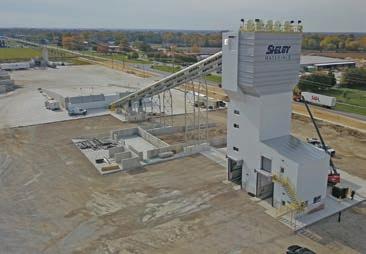
3 minute read
Green Initiatives Serve Communities & The Bottom Line
Shelby Materials
Shelby Materials customizes an Astec Industries BMH Central Mix Plant to meet sustainable goals.
Investing in equipment that not only helps you meet production goals but also contributes to your company's Environmental Health & Safety initiatives is a trend that will continue to grow in the construction industry. Governments and communities increasingly expect businesses to support broader goals, such as sustainability, and construction business owners need to be ready to step up in order to stand out.
Shelby Materials, a ready-mix concrete and aggregate material supplier throughout Greater Indianapolis and Central Indiana, knows the importance of differentiating your business in a particularly competitive market. “[We] began as a small-town-company and we are still family-owned and operated,” says Matt Haehl, President of Shelby Materials. The company has 10 plant locations and purchased their first BMH Astec plant six years ago. They knew the Franklin plant would be a BMH system as well, but wanted to add new features that would allow them to accomplish community and environmental goals.
Saving about 160+ tons of carbon, the Shelby team brought in reclaimers, used liquid fly ash for the 6,000 yards of pavement, and used type 1L cement with an admixture product to reduce the cement content. By doing this, they did not have to use sealers on the concrete and further lowered their environmental impact.
“We had a great relationship with BMH for years and this being our third permanent BMH plant, but first under the Astec umbrella,” Haehl says. “We had an idea of what we want to work with in Franklin and the Astec team are the professionals in the plant construction business so they took our ideas and made suggestions for the location and ran with it.”
The suggestions included fullyenclosed insulated panels to help with heat retention, a gravity-fed system instead of conveyors (saving further money on maintenance), a state-of-theart interior “on demand dust control system, and automatic pressure system outside—saving thousands of dollars each year on filters alone.
ON-DEMAND HEATING
Drying aggregates requires heat and that energy usage adds up quickly. Plant owners can counteract those prices by using on-demand heating systems.
Shelby installed a Polarmatic System which uses the heat much more efficiently and finding them savings.
“When we’re heating materials, we’re going to be using all that gas and everything to heat our water anyhow,” Harman says. “With the Polarmatic, instead of just having the flue gasses or the heat exhaust into the atmosphere, we redirect that to each and every ag bin. We have valves that will turn on or turn off depending on how often we want to put that heat into each individual aggregate, whether it's the course or the fine. So essentially, we're utilizing something that we already had to give us a better quality of a product.”
Shelby’s New Astec BMH Central Mix Plant At A Glance
• Fully enclosed with insulated panels (Green System) • Gravity feed aggregate and cement (Green System) • On-Demand aggregate heating system (Green System) • Double feed aggregate handling system (36 in. wide belts, 750 tons/hour) • Aggregate storage bins (370-ton capacity, 6 compartments) • Aggregate weigh hopper (12-yard, 40,000-lb. capacity) • Cement storage bins ( 480-ton capacity, 6 compartments) • Rollmaster drum mixer (12-yard capacity, 1 in. thick with urethane liners) • Bolt in liners for aggregate loading hoppers and aggregate storage bins • 304 Stainless steel water holding hoppers • Central dust collection system (Green System)
CONSISTENT SUPPORT AT EVERY STEP
“With the BMH Astec transition, service has never been better,” says Haehl. “Now that service is stateside, they're pretty close to us if we need anything and it’s really been a pretty easy transition.””
And the partnership with Astec and Shelby will continue for years to come as they navigate a sustainable roadmap for the future together.
Edited for print. Find the full story and more about concrete plants at










